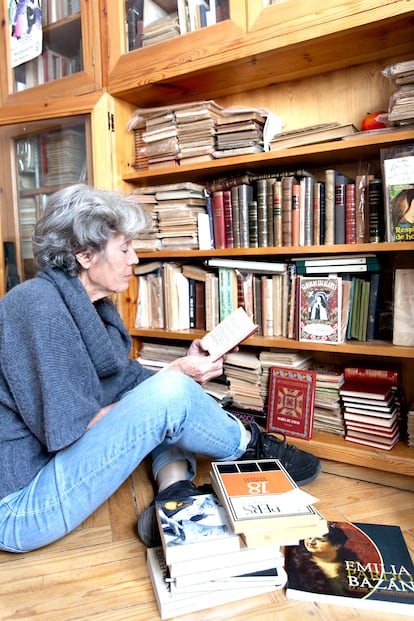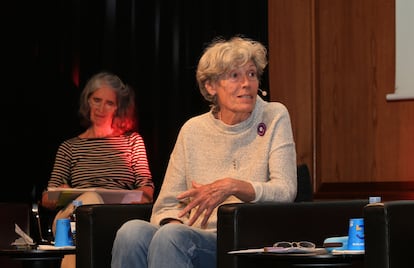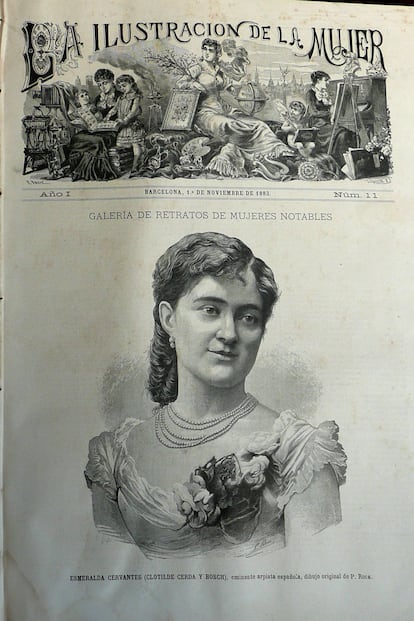We walked on words that were before and invented new ones. When Virginia Woolf wrote that a woman needs her own room (and money, he also said) to devote himself to literature, he already recognized that “leaves without solving the great problem of the true nature of women and the true nature of literature.” As many writers have demonstrated, to have that own room is not necessary to write (either money), but the idea of the own room It is because it has become a symbol that transcends the mere physical space. It is, however, a physical space, a stable and permanent headquarters, what the Women’s Library needs, which exceeds thirty thousand volumes. More than forty years ago than her driver, the documentary filmmaker Marisa Mediavilla (Palencia, 80 years), began to acquire all kinds of books and publications of women, and about women.
The library, assigned to the Women’s Institute in 2006, is distributed by several provisional locations. Since 2012, most books are in the Madrid suit museum; And two other boxes, unopened, are kept among the premises of the number 4 of Bravo Murillo Street in Madrid, belonging to the current Women’s Institute, and dependencies of the City Council of Coslada. “Germany, France, Italy, Belgium, the Nordic countries, all have their Women’s Library, why not here? Why do we accept not to have memory?” Asks Marisa Mediavilla, whose professional work, as a librarian, was linked to the central service of the Public Library Network of the Community of Madrid.
“Sometimes they tell me, and why a women’s library if the National Library has everything? And I say that, following that criterion, then there are all other libraries. And it is also not true that the National Library has everything. In the Women’s Library there are things that are not in other libraries. I went to work in 1975, when Franco died, and then a lot of editorials began to publish. Extraordinary public, Alicia Girón, and what was published of women in those years bought everything for libraries, ”explains the documentary filmmaker.
When Mediavilla retired, there was no one of those publications, “because public libraries are not conservation libraries. When there are news and you enter them, you have to expose and empty, and it begins with the books that have been lent less. The background of women used to be one of the ones that were less consulted and that is why it was exhibited, but not by misogyny, but simply because it had been consulted.

That lack of interest in writers’ books or publications for or about women contrasts with the dissemination and claim that is being produced in the last years of many unjustly forgotten authors. Especially those of the twentieth century, which are precisely those that nourish the Library of Women created by Marisa Mediavilla, helped by collaborators such as the writer Lola Robles and Ricarda Fucla, with which Marisa Mediavilla has made a Women’s Tesaurus which has been eight thousand downloads.
Another sample of the interest in the creations of the authors is the numerous assistance and monitoring that last May the I State Women and Literature Meeting, held at the headquarters of the Cervantes Institute, in Madrid, and promoted by the Association of Women Writers and Illustrators (AMEIS) and the Collegiate Association of Writers and Writers (ACE).
One of the points of the manifesto resulting from that meeting claims precisely “a worthy headquarters for the Women’s Library” that is completed in a permanent and accessible space in the center of Madrid. AMEIS and ACE also propose that the management of this headquarters is carried out jointly between the Women’s Institute, under the Ministry of Equality, and the General Directorate of the Book, of the Ministry of Culture, so that this collaboration serves to unlock the situation of the Women’s Library. “What is not named, does not exist; and what is not seen, does not exist. And this library, which is already formed and that is the work of a lifetime, an impressive research work, is valuable for all and for everyone, so that whoever wants to investigate in it can do it.”

“The Women’s Library exists in other European cities and also in Barcelona there is a Library of the Dona (the Francesca Bonnemaison Library), so nothing strange is being requested and I think it is now a good time for this project,” says Carmen Peire, president of the Ameis Association. “There is still a pending debt to what a whole series of women contributed to the literary world,” he adds, and recalls that that is why Marisa Mediavilla granted the first silver AMEIS, the main award of the association. Mediavilla has also received the Legend Award from the Madrid Libreros Guild.
“The Ministry of Culture has a section of specialized libraries, so it is not about creating anything new. This is a specialized library, just as there are other topics. The important thing is that it has its own space, a differentiated identity,” says Marisa Mediavilla. It was in the seventies when Mediavilla began buying books by authors or referring to women, although the eighties were the beginning of a more systematic work of compilation. Among the volumes of the Women’s Library predominate the books and publications of the twentieth century, but also of the 19th century, such as the magazine The illustration of women. And highlights the collection of comics aimed at women, such as Florita, Azucena, My girls, Scales, Swallow y Fifth avenueamong others. There are also magazines from all over the world, “feminist and antifeminists,” says Mediavilla, because the library also collects publications and books that have referred to women in a denigrating or paternalistic way. “Being a library specialized in women, any ideological and political opinion is collected. Everything that refers to women appears and how it has been seen,” he says.
On their preferences, Mediavilla highlights the authors of the first third of the twentieth century: “They are all extraordinary. They have been a discovery for me and for many women who in the seventies and in the eighties we began to wake up already wanting to know the history of the women who had preceded us. And that forbade us to study until 1910, that you can hardly even believe it. But these authors were very good. Campoamor, but there was a lot. ” Marisa Mediavilla’s idea is that the library also collects donations, because there are many valuable authors and books to discover. But that will be if the Women’s Library manages to leave the basements and the boxes and finally achieves its own room.

